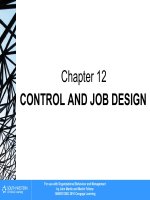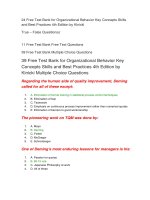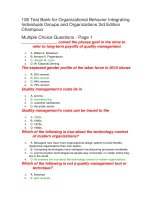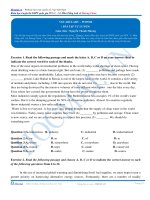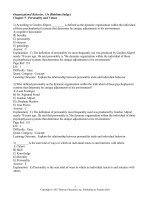Lecture Organizational behavior - Chap 12: Power and politics
Bạn đang xem bản rút gọn của tài liệu. Xem và tải ngay bản đầy đủ của tài liệu tại đây (4.18 MB, 27 trang )
Chapter 12
Power and Politics
Make connections, gain
power and influence
Chapter 12 Study
Questions
What is power and why is it important?
What are the sources of power and influence?
How do people respond to power and influence?
What is organizational politics?
How do individual navigate politics in
organizations?
Copyright © 2014 John Wiley & Sons,
12-2
What is power and why is it
important?
Power
• The ability to get someone to do something you
want done.
• The ability to make things happen in the way you
want.
Social Power
• A term used to recognize that power comes from
the ability to influence another in a social relation.
Force
• Power made operative against another’s will.
Copyright © 2014 John Wiley & Sons,
12-3
What is power and why is
it important?
Power and Dependence
• Dependency – One Person or group relies on
another person or group to get what they want
or need.
• Control – Authority or ability to exercise
restraining or dominating influence over
someone or something.
Copyright © 2014 John Wiley & Sons,
12-4
What is power and why is
it important?
The Problem of Powerlessness
Powerlessness is defined as a lack of autonomy
and participation.
Copyright © 2014 John Wiley & Sons,
12-5
What is power and why is
it important?
Power as an Expanding Pie
• Empowerment – involves sharing power,
information, and rewards with employees to
make decisions and solve problems in their
work.
• Zero Sum Game – one person’s gain in equal to
another person’s loss (“I win, you lose”).
Copyright © 2014 John Wiley & Sons,
12-6
FIGURE 12.1 Hypothetical
psychological contract
for a secretary.
Copyright © 2014 John Wiley & Sons,
12-7
What are the sources of
power and influence?
Two primary sources of power:
Position
• Derives from a person’s position in the
organization.
Personal
• Resides in the individual.
• Independent of that individual’s position.
Copyright © 2014 John Wiley & Sons,
12-8
What are the sources of
power
and influence?
Types of position
power
Copyright © 2014 John Wiley & Sons, Inc.
12-9
What are the sources of
power and influence?
Legitimate power
• The extent to which a manager can use
subordinates’ internalized values or beliefs that
the “boss” has a “right of command” to control
their behavior.
Copyright © 2014 John Wiley & Sons,
12-
What are the sources of
power and influence?
Hierarchical Thinking
• The problem of deferring responsibility and
accountability upward in organizations.
Reward Power
• Comes from one’s ability to administer positive
rewards and remove or decrease negative rewards.
Coercive power
• The extent to which a manager can deny desired
rewards and administer punishments to control other
people.
Copyright © 2014 John Wiley & Sons,
12-
What are the sources of
power and influence?
Personal power
• Expert Power – The power a person has because of
special skills and abilities that others need but do not
possess themselves.
• Referent Power – The ability to alter another’s behavior
because of the individual’s desire to identify with the
power source.
Copyright © 2014 John Wiley & Sons,
12-12
What are the sources of
power and influence?
Connection Power
• The ability to call on connections and networks both
inside and outside the organization for support in getting
things done and in meeting one’s goals.
Association Power
• Arises from influence with a powerful person on whom
other depend.
Copyright © 2014 John Wiley & Sons,
12-13
What are the sources of
power and influence?
Reciprocal Alliances
• Represents the power arising from alliances with others
developed through reciprocity (the trade of power or
favors for mutual gain in organizational transactions).
Copyright © 2014 John Wiley & Sons,
12-
In your experience
Which personal power would you likely use to
request a promotion?
a. Coalition
b. Rational persuasion
c.
Expertise
Copyright © 2014 John Wiley & Sons,
12-
How do people respond to
power and influence?
Responses to Power and Influence
Conformity –
• Compliance – occurs when individual accept another’s influence
because of the positive or negative outcomes tied to it.
• Identification – occurs when individuals accept an influence
attempt because they want to maintain a positive relationship
with the person or group making the influence request.
• Internalization – occurs when an individual accepts influence
because the induced behavior is congruent with their value
system.
Copyright © 2014 John Wiley & Sons, Inc.
12-16
How do people respond
to power and influence?
Resistance
• Constructive Resistance
Characterized by thoughtful dissent aimed at constructively
challenging the influencing agent to rethink the issue.
• Dysfunctional Resistance
Involves a more passive form of non-compliance in which
individuals ignore or dismiss the request of the influencing
again.
Copyright © 2014 John Wiley & Sons, Inc.
12-
How do people respond
to power and influence?
How Power Corrupts
• Bathsheba Syndrome
When men and women of otherwise strong personal
integrity and intelligence engage in unethical and
selfish behavior in the pinnacle or power because
they mistakenly believe they are above the law.
Copyright © 2014 John Wiley & Sons,
12-
What is organizational
politics?
Why do we have organizational politics?
• Formal Systems
Dictate what is to be done in organizations and how work
processes are to be coordinated and structured.
• Informal Systems
Patterns of activity and relationships that arise in everyday
activities as individuals and groups work to get things done.
Copyright © 2014 John Wiley & Sons,
12-19
What is organizational
politics?
The Role of SelfInterest
• Self-interested Politics
Occur when individuals or groups work to shift
otherwise ambiguous outcomes to their
personal advantage without consideration of
the organization or coworkers.
Copyright © 2014 John Wiley & Sons,
12-20
What is organizational
politics?
Political Climates
• Organizational Political Climate
The shared perceptions about the political nature of the
organization.
• Workarounds
Working around the system to accomplish a task or goal
when the normal process or method isn’t producing the
desired result.
Copyright © 2014 John Wiley & Sons,
12-
How do individual navigate
politics in organizations?
Building Power Bases
• Power Bases
The sources of power individuals and
subunits develop in organizations.
Non-Substitutable means the individual or
the work performed by the subunit cannot be
easily replaced.
Copyright © 2014 John Wiley & Sons,
12-
Figure 12.2 Building power
bases
Copyright © 2014 John Wiley &
12-23
How do individual navigate
politics in organizations?
Developing Political Skills
• Political Savvy
The skill and adroitness at reading political
environments and understanding how to influence
effectively in these environments.
Copyright © 2014 John Wiley & Sons,
12-
How do individual navigate
politics in organizations?
Networking
• Social Capital
The current or potential resources gained through one’s
network.
• Human Capital
The knowledge, skills and intellectual assets employees
bring to the workplace.
Copyright © 2014 John Wiley & Sons,
12-25

